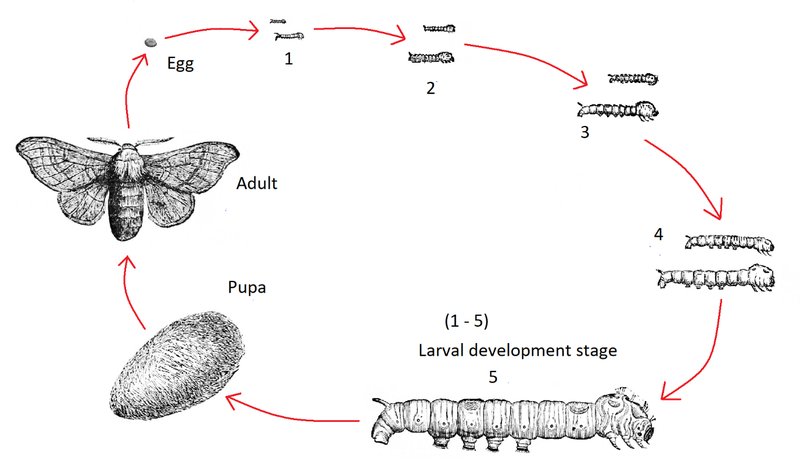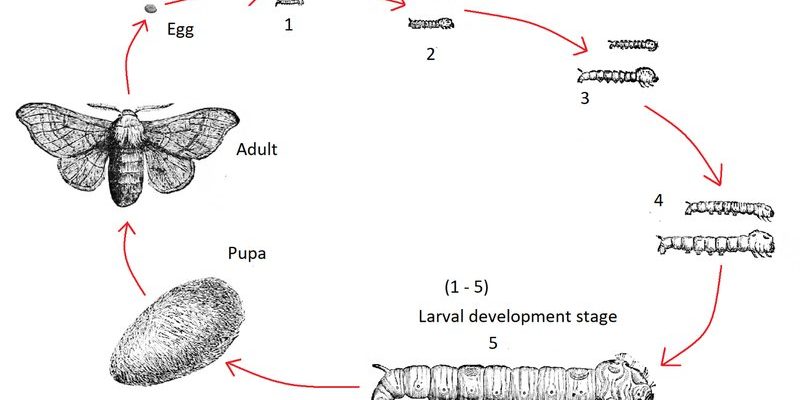
Imagine a moth’s life like a dramatic movie with multiple acts, each one showcasing a different character. The first act starts with a tiny egg, a process that sets the stage for everything that follows. By the end of this journey, we’ll witness a beautiful adult moth fluttering in the night. So grab your coffee, and let’s dive into the world of moths!
Stage 1: The Egg
The moth’s lifecycle begins with the egg stage. This tiny, often round or oval shape is where it all starts. The mother moth lays her eggs on surfaces that will help the larvae thrive when they hatch. Think of it like planting seeds in a garden—she carefully chooses the right spot.
Each egg can vary in size and color, depending on the moth species. For instance, some are small and white, while others might be a bit larger and patterned. This careful selection of laying spots ensures that the future caterpillars have enough food when they emerge. The egg stage usually lasts about a week or two, but this depends on environmental conditions like temperature and humidity.
Once the time is right, the eggs hatch. You might be wondering, what happens inside that egg? Well, the embryos develop during this time, feeding off the yolk of the egg. It’s like being in a cozy little cocoon before the big reveal!
Stage 2: The Caterpillar (Larva)
After hatching, the tiny creature that emerges is called a caterpillar, or larva. This stage is all about growth. The caterpillar’s main job is to eat—eating and more eating! These little munchers are often seen devouring leaves and other plants. Honestly, they can eat so much that they grow quickly.
As they consume various plant materials, they undergo molting. This means they shed their skin multiple times to accommodate their growing bodies. It’s kind of like outgrowing your favorite pair of shoes and needing to find a new size. Gross, right? But it’s a normal part of their development.
During this phase, many caterpillars can be quite colorful and even have certain markings that warn predators to stay away. Some might blend in with their surroundings, using camouflage to avoid getting eaten. This hunger-driven phase lasts several weeks, and by the end, the caterpillar is ready for the next big step in its remarkable journey.
Stage 3: The Chrysalis (Pupa)
Once the caterpillar has fattened up, it’s time for the third stage: the chrysalis or pupa. This stage can feel like a dramatic pause in the moth’s story. The caterpillar finds a safe place—like a branch or a hidden nook—and forms a protective casing around itself.
Inside this casing, known as a chrysalis, a remarkable transformation takes place. Here’s the thing: the caterpillar doesn’t just grow wings; it undergoes a complete metamorphosis. Its body breaks down and reorganizes into the structure of a moth. This process, called metamorphosis, might take several weeks, and during this time, the chrysalis can be still and quiet, almost like a superhero in a secret lair waiting to debut its superpowers.
When the time is right, the chrysalis cracks open, revealing a newly formed moth. It’s an incredible moment that signifies the end of one life stage and the exciting start of another!
Stage 4: The Adult Moth
Finally, we arrive at the grand reveal: the adult moth. Once it emerges from the chrysalis, the moth’s wings are crumpled and wet. It needs some time to pump fluids into them, allowing them to expand and dry. Picture it strutting onto the scene, wings glistening in the light.
Adult moths typically spend their time searching for food, finding mates, and, if they’re lucky, laying eggs to continue the cycle. Many adult moths are nocturnal, fluttering around lights at night. This can be a bit of a surprise if you expect to see them during the day!
Adult moths have different lifespans depending on the species, ranging from a few weeks to several months. Once they’ve fulfilled their life cycle, they’ll eventually die, leaving behind eggs that maintain the cycle of life. Isn’t it amazing how life continues in such an intricate way?
The Importance Of Moths In Nature
You might be wondering why understanding the lifecycle of a moth matters. Moths play essential roles in ecosystems. They are pollinators, helping plants reproduce, much like bees. Moreover, they serve as prey for various animals, like birds and bats. This connection tells a story of balance in nature.
Their presence in the environment can indicate the health of ecosystems. For example, if moth populations decrease, it might suggest that something is amiss, possibly due to habitat loss or pollution. Recognizing their lifecycle is not just about appreciating their beauty; it’s about acknowledging their role in our world.
Common Myths About Moths
Despite their fascinating lives, moths often carry misconceptions. For example, many people think all moths are dull and gray, but moths come in endless colors and patterns. Some even resemble butterfly species! Another myth is that moths are just pests; while they can sometimes damage clothing or stored food, they also serve vital ecological functions.
Honesty, moths are often overlooked because they come out at night, unlike butterflies. But their nighttime activities are just as important. By debunking these myths, we can appreciate the beauty and uniqueness of these creatures even more.
How To Observe Moths
If you’re feeling inspired and want to observe moths in action, there are plenty of ways to do it! Setting up a simple moth trap can help attract them to your yard. Use a light source, like a porch light or a specially designed moth trap, to draw them in.
Here’s a quick way to attract moths:
- Set up a white sheet in your yard.
- Place a bright light nearby.
- Wait quietly and watch as moths gather!
Remember, they are more active at night, so get ready for an evening adventure. With a little patience, you might be surprised by the variety of moths that come to check out your light!
In conclusion, the lifecycle of a moth—from its humble beginnings as an egg, to a ravenous caterpillar, through the transformative chrysalis, and finally to a beautiful adult—is a captivating journey. Moths remind us of the incredible changes that happen all around us, often unnoticed. So next time you see a moth fluttering by, take a moment to appreciate its remarkable story!

